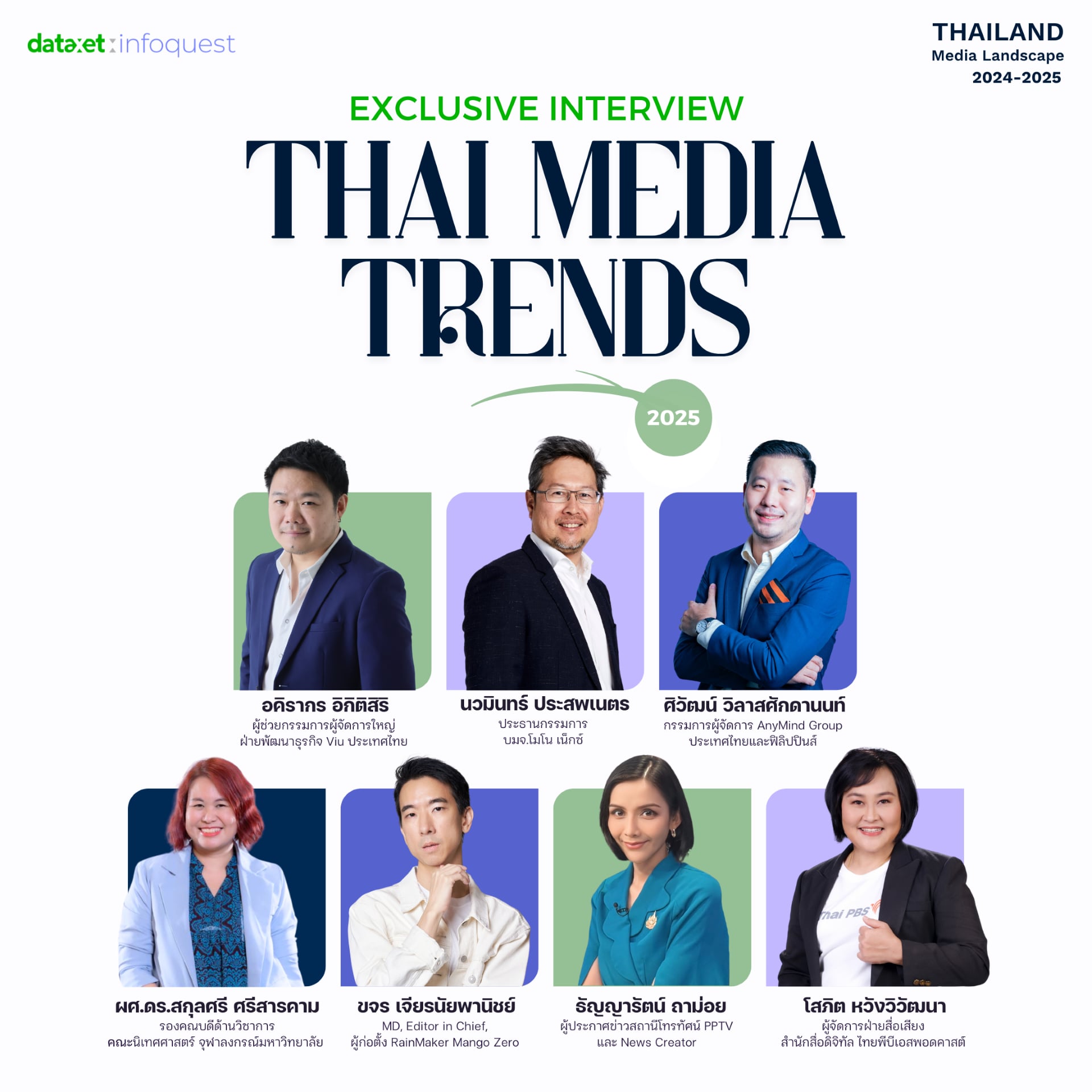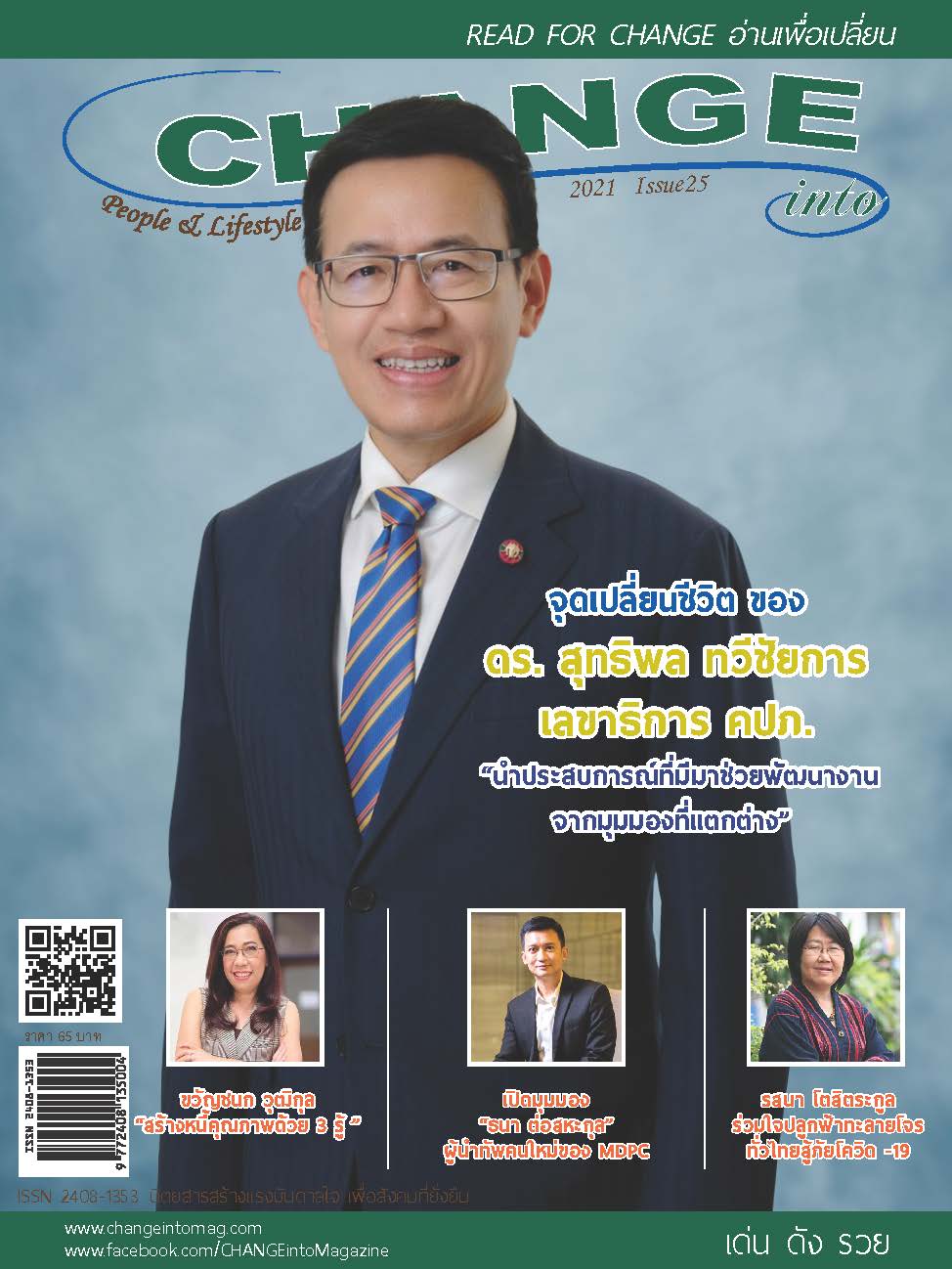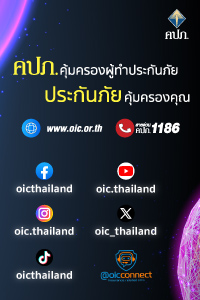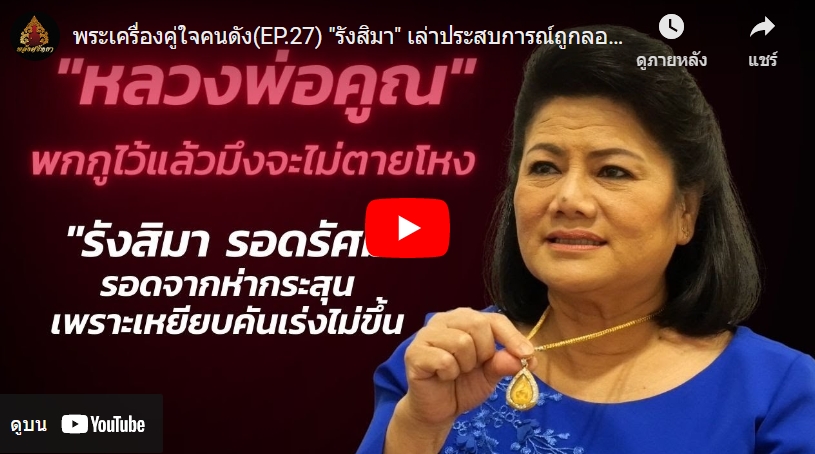เปิดมุมมอง 7 กูรู ดูโอกาสและอุปสรรคสื่อไทยปี 2568

เปิดมุมมอง 7 กูรู ดูโอกาสและอุปสรรคสื่อไทยปี 2568
สื่อไทยยังคงมีโอกาสเติบโตท่ามกลางการแข่งขันกับกลุ่มอินฟลูเอนเซอร์และคอนเทนต์ครีเอเตอร์ กุญแจสู่ความสำเร็จคือการปรับการผลิตคอนเทนต์ให้ตอบโจทย์กลุ่มเป้าหมายและอัลกอริทึมของแพลตฟอร์ม ซึ่งจะนำไปสู่โมเดลธุรกิจรูปแบบใหม่ อย่างไรก็ตาม พฤติกรรมของผู้บริโภคและสภาพเศรษฐกิจของประเทศยังคงเป็นความท้าทายสำคัญ แล้วแนวโน้มสื่อในปี 2568 จะเป็นอย่างไร 7 กูรูจากหลากหลายวงการพร้อมแล้วที่จะมาแบ่งปันมุมมองในเรื่องนี้
ผศ.ดร.สกุลศรี ศรีสารคาม รองคณบดีด้านวิชาการ คณะนิเทศศาสตร์ จุฬาลงกรณ์มหาวิทยาลัย มองว่า สื่อดั้งเดิมอย่างทีวี หนังสือพิมพ์ คงจะยังไม่หายไปภายในระยะเวลา 5 ปี แต่ว่าคนดูจะลดลง เม็ดเงินที่จะเกิดขึ้นที่สื่อเหล่านั้นก็จะน้อยลง นอกจากนี้ Ecosystem ของไทยมี Creator Economy เป็นปัจจัยสำคัญที่ทำให้เกิดการแข่งขันและตัวเลือกของผู้รับสารหรือผู้บริโภคด้วย
“เพราะฉะนั้นความยากของคนทําสื่อในบ้านเราคือ ไม่ใช่แค่ทะลุอัลกอริทึมอย่างเดียวแล้ว คุณจะทะลุ Personalization ของคนได้ยังไง เราตั้งคําถามเสมอว่าเราจะทําให้คนกลับมาเข้าหน้าเว็บไซต์สื่อได้ยังไง ซึ่งทุกคนพยายามแต่มันก็ยากมาก แต่ถามว่าสุดท้ายเราต้องทําแพลตฟอร์มที่เป็นของเราเองไหม เพื่อลดความพึ่งพิงโซเชียลมีเดียลง เราก็ต้องทำค่ะ เพราะถ้าไม่ทําสุดท้ายเราก็จะถูกโซเชียลมีเดียกินไปหมด Audience ก็จะหายไปอย่างสิ้นเชิง”
ความเห็นดังกล่าวสอดคล้องกับมุมมองของคุณนวมินทร์ ประสพเนตร ประธานกรรมการ ประธานกรรมการบริหาร บมจ.โมโน เน็กซ์ ที่มองว่า ทีวีดิจิทัลอยู่ในช่วงขาลง เนื่องจากพฤติกรรมผู้บริโภคที่เปลี่ยนแปลงไป ทางเลือกในการรับชมที่หลากหลาย ตลอดจนบทบาทของเทคโนโลยีและสภาพเศรษฐกิจ โมโน เน็กซ์จึงได้ปรับทิศทางการทำธุรกิจด้วยการชูแพลตฟอร์มสตรีมมิ่ง “MONOMAX”
ในขณะที่ คุณอคิรากร อิกิติสิริ ผู้ช่วยกรรมการผู้จัดการใหญ่ฝ่ายพัฒนาธุรกิจ Viu (วิว) ประเทศไทย มองแนวโน้มตลาดธุรกิจสตรีมมิ่งและคอนเทนต์ในไทยและเอเชียตะวันออกเฉียงใต้ปี 2568 ว่า จะมีความดุเดือดและสนุกสนานมากขึ้น เพราะมีทั้งผู้ให้บริการรายใหม่ที่เข้ามา ตลอดจนคอนเทนต์ที่พัฒนาไปอย่างก้าวกระโดด สอดรับกับพฤติกรรมผู้บริโภคที่เปลี่ยนจากการดูทีวีมาสู่สตรีมมิ่ง
ทั้งนี้ เราปฏิเสธไม่ได้เลยว่า คอนเทนต์ครีเอเตอร์และอินฟลูเอนเซอร์ยังคงเป็นความท้าทายที่สำคัญสำหรับสื่อ ในเรื่องนี้ คุณธัญญารัตน์ ถาม่อย ผู้ประกาศข่าวของสถานีโทรทัศน์พีพีทีวี และ News Content Creator เล่าว่า สถานีฯ มีนโยบายให้นักข่าวมีโซเชียลมีเดียแพลตฟอร์มในการกระจายข้อมูลข่าวสารไปยังผู้ชม เพราะเป็นช่องทางที่สามารถสื่อสารแบบเปิดหน้าคุยได้ ทำให้คนรู้จักมากขึ้น และยังเป็นช่องทางสร้างรายได้
ในฝั่งของผู้บริหารแพลตฟอร์มอินฟลูเอนเซอร์นั้น คุณศิวัฒน์ วิลาสศักดานนท์ กรรมการผู้จัดการ AnyMind Group ประเทศไทยและฟิลิปปินส์ เผยปัจจุบันการตลาดอินฟลูเอนเซอร์ (Influencer Marketing) ไทยอยู่ใน Evolution ที่ 3 ซึ่งเป็นช่วงเวลาของนาโนและไมโครอินฟลูเอนเซอร์ โดยช่วง Evolution ที่ 1 (ก่อนปี 2553) ส่วนใหญ่อินฟลูเอนเซอร์จะเป็นดารา นักแสดง หรือนักกีฬาที่ถูกนำมาใช้ในโฆษณา ตามด้วย Evolution ที่ 2 (หลังปี 2553) เป็นเทรนด์ของโซเชียลมีเดีย ไม่ว่าจะเป็นบล็อกเกอร์ด้านอาหารหรือด้านความงาม คนที่ไม่ได้เป็นดาราแต่ว่าดังมาจากโซเชียลมีเดียช่องทางต่าง ๆ
นอกเหนือจากตัวครีเอเตอร์แล้ว อีกปัจจัยสำคัญที่ขับเคลื่อนวงการคือ อัลกอริทึม โดยเฉพาะติ๊กต๊อก (TikTok) ที่คุณขจร เจียรนัยพานิชย์ Managing Director, Editor in Chief, ผู้ก่อตั้ง RainMaker / Mango Zero มองว่า ติ๊กต๊อกได้เปลี่ยนบทบาทจาก “แอปจริตจีน” สู่แพลตฟอร์มโซเชียลคอมเมิร์ซที่มียอดขายเทียบเท่าอีคอมเมิร์ซชั้นนำ ความสำเร็จในการสร้างกระแส “ปักตะกร้าขายสินค้า” เกิดจากการเป็นแพลตฟอร์มอีคอมเมิร์ซเดียวที่มีคอนเทนต์มากที่สุด ผู้ใช้งานทั่วไปเปิดแอปอีคอมเมิร์ซเพื่อซื้อสินค้าอย่างเดียว แต่การเปิดติ๊กต๊อกคือการเสพคอนเทนต์ ซึ่งมีการขายสินค้าแทรกอยู่ภายใน
ขณะที่สื่อหลักต่างปรับตัวรับความท้าทาย ยังมีสื่อหนึ่งที่สามารถเติบโตและมีแนวโน้มว่าจะได้รับความนิยมอย่างต่อเนื่อง นั่นก็คือ พอดคาสต์ (Podcast) โดยคุณโสภิต หวังวิวัฒนา ผู้จัดการฝ่ายสื่อเสียง สำนักสื่อดิจิทัล ไทยพีบีเอสพอดคาสต์ มองว่า ความก้าวหน้าด้านเทคโนโลยีทำให้มีแพลตฟอร์มและแอปพลิเคชันที่ฟังได้โดยไม่จำกัดเวลา สอดคล้องกับพฤติกรรมของคนฟังที่รับข้อมูลทางออนไลน์เพิ่มขึ้น อย่างไรก็ตาม พอดคาสต์ในไทยยังต้องแข่งกับวิดีโอทั้งจากยูทูบหรือเฟซบุ๊ก เพราะว่าผู้คนนิยม “ดูและฟัง” มากกว่า “ฟัง” อย่างเดียว ด้วยเหตุนี้ จึงมีการคาดการณ์ว่า วิดีโอพอดคาสต์ จะเป็นสื่อที่มีการผลิตมากยิ่งขึ้นเพื่อจับกลุ่มเป้าหมายนี้
ในภาพรวม สื่อไทยปี 2568 ยังคงต้องปรับตัวตามเทคโนโลยีและพฤติกรรมของผู้บริโภค เพื่อเพิ่มความสามารถในการแข่งขันและอยู่รอดในตลาดที่เต็มไปด้วยความท้าทาย
อ่านบทสัมภาษณ์ชิ้นเต็มและแนวโน้มสื่อไทยกันได้แล้วที่ https://www.dataxet.co/media-landscape/2025-th/thai-media-trends
7 Industry Leaders Map Thai Media’s Challenges and Opportunities for 2025
Thai media sees growth opportunities through strategic adaptation to audience preferences and platform algorithms, despite fierce competition from influencers and content creators. Success hinges on developing innovative business models, though shifting consumer habits and economic headwinds pose ongoing challenges. Seven leading industry experts share their perspectives for Thailand's media landscape in 2025.
Assistant Professor Dr. Sakulsri Srisaracam, Deputy Dean of Academic Affairs at Chulalongkorn University's Faculty of Communication Arts, believes that traditional media will survive the next five years but face declining audiences and ad revenues. The rise of Thailand's Creator Economy has become a pivotal force reshaping competition and expanding viewer choices.
"The challenge for media professionals in our country isn't just about breaking through algorithms anymore. It's about how to break through people's personalization preferences. Getting audiences back to media websites remains an uphill battle. Everyone tries, but it's very difficult. We must develop our own platforms to reduce social media dependency – otherwise, we risk losing our entire audience to these platforms."
This view aligns with Navamin Prasopnet, Chairman and Chairman of Executive Committee of Mono Next PCL, who sees digital TV in decline due to changing consumer behavior, diverse viewing options, technological roles, and economic conditions. In response, Mono Next has adjusted its business direction by focusing on the "MONOMAX" streaming platform.
Akirakorn I-kitisiri, Assistant Vice President, Business Development at Viu Thailand, predicts that the streaming and content market in Thailand and Southeast Asia will become more intense and exciting in 2025, with new service providers entering the market and content developing rapidly, responding to consumers' shift from TV to streaming.
For traditional media, content creators and influencers remain a significant challenge. Thanyarat Thamoi, a news anchor at PPTV and News Content Creator, shares that the channel has a policy encouraging journalists to maintain social media platforms for news distribution, as it enables direct communication with viewers, increases recognition, and provides additional revenue streams.
This shift in media dynamics has paralleled the evolution of influencer marketing itself. Siwat Vilassakdanont, Managing Director of AnyMind Group Thailand and Philippines, reveals that Thai influencer marketing is currently in its third evolution, characterized by nano and micro-influencers. The first evolution (pre-2010) mainly featured celebrities and athletes in advertising, while the second evolution (post-2010) saw the rise of social media influencers like food and beauty bloggers.
Beyond creators and influencers, algorithms are another crucial industry driver, especially TikTok. Khajorn Chiaranaipanich, Managing Director, Editor in Chief, and founder of RainMaker / Mango Zero, observes that TikTok has transformed from a "Chinese app" into a social commerce platform with sales comparable to leading e-commerce platforms. TikTok's success in creating the 'shopping basket' trend stems from being the only e-commerce platform with the highest content volume. While users typically open e-commerce apps solely to make purchases, they open TikTok to consume content – with product sales seamlessly integrated within.
As media platforms evolve across different formats, podcasts have emerged as another promising medium. Sopit Wangwiwat, Audio Media Manager at Thai PBS Digital Media Department, notes that technological advancement has enabled platform and application accessibility without time constraints, matching listeners' increasing online consumption habits. However, podcasts in Thailand still compete with video content from YouTube or Facebook, as people prefer to "watch and listen" rather than just "listen." Consequently, video podcasts are expected to see increased production to capture this target audience.
Overall, Thai media faces a defining moment in 2025, where success will go to those who best understand technology and changing consumer needs.
Read the Exclusive Interview in Thai at: https://www.dataxet.co/media-landscape/2025-th/thai-media-trends
Read the Exclusive Interview Highlights and Key Take-aways:
https://www.dataxet.co/media-landscape/2025-en/thai-media-trends




















